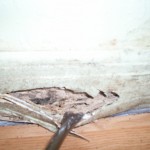 A disgruntled homeowner was once asked how his termite inspection went and if he had any damage?
A disgruntled homeowner was once asked how his termite inspection went and if he had any damage?
He replied;
I ended up with damage alright but it wasn’t from termites. The inspector checking for them drove a screwdriver into all of my baseboards and window sills! Who’ll fix that?
This unfortunately is a common problem and it can be much worse than that. For some reason there are wdo (wood destroying organism) inspectors who must think it is there right or duty to gouge your baseboards, wood trim and bang dents in your drywall in the name of termite inspecting. They may use knives, screwdrivers, awls or picks but whatever the tool is the only damage visible when they are done poking around is from them.
I’m not sure what the rules or laws are in every state but for the most part I’m sure this type of invasive probing is not in the ‘spirit’ of what is allowed. In Florida you are only suppose to pry or probe when visible evidence is present of a wdo and then only enough so you can make a positive id. Anything else is considered defacing property and besides that it is mostly unnecessary.
A visual inspection
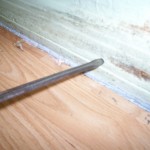 The biggest knock on termite inspectors is they can only see about 10% or less of any structure they inspect. You can’t see through the drywall to view the studs, you’re not required or sometimes even able to move all the furniture away from the walls and even the attic with all of its exposed roof trusses has half or more of its termite food hidden by insulation. Termite inspections are meant to be visual inspections only and as such an inspector who is already limited is even more so restricted if he relies on just his vision alone.
The biggest knock on termite inspectors is they can only see about 10% or less of any structure they inspect. You can’t see through the drywall to view the studs, you’re not required or sometimes even able to move all the furniture away from the walls and even the attic with all of its exposed roof trusses has half or more of its termite food hidden by insulation. Termite inspections are meant to be visual inspections only and as such an inspector who is already limited is even more so restricted if he relies on just his vision alone.
What most states have done for this dilemma is added verbiage to their rules that allow for ‘tapping’ 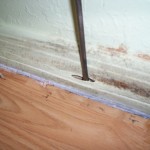 of wood trim and baseboards. This added language is supposed to aid the technician in his quest to find hidden damage and galleries that termites have caused by their feeding. What has happened for the most part is inspectors interpret this to mean they can beat the daylight out of your home and repeatedly stab at its exposed wood with no regard since in their mind, ‘it falls under the job description.’
of wood trim and baseboards. This added language is supposed to aid the technician in his quest to find hidden damage and galleries that termites have caused by their feeding. What has happened for the most part is inspectors interpret this to mean they can beat the daylight out of your home and repeatedly stab at its exposed wood with no regard since in their mind, ‘it falls under the job description.’
Sound thinking
You might think that the tapping would produce a special hollow sound and that is what the inspectors are listening for. To a point you are right, severely damaged wood does give off a hollow sound when tapped. I can even hear it at times when I’m treating with a liquid sprayer and the pin stream hitting the frail wood gives a distinct noise. What tapping really exposes however is the weak wood and the thin baseboard or trim that gives way when firmly struck. At that point an inspector is well within the definition to probe just enough to confirm or even rule out termites. In no description or modicum of common sense should it allow you to rip half the baseboard away just because of a small area of weakened wood.
Using other methods to probe
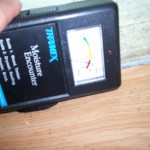 A good inspector uses more than just a screwdriver and as a matter of fact he usually uses the handle of the screwdriver for tapping and only the blade when he deems it necessary to probe. Other non invasive tools may be a moisture meter that can detect the presence of excess moisture inside the walls. Subterranean termites require about 20% moisture when they leave the soil and if they can’t find it they’ll bring it up in the form of soil. They even construct mud tubes that help them keep in the precious moisture that they need. Your hands and fingers are another excellent way to feel for abnormalities and after years of experience you can find termites with your sense of touch. I’m constantly running my hands around window and door frames feeling for bubbled paint or soft wood. A magnifying glass is a must for any inspector’s tool kit as it will allow you to see even the tiniest detail of evidence that only termites leave behind. Small picks like dental tools and a hacksaw blade for retrieving evidence from the thinnest of cracks. Termite collection devices to physically suck termites and termite evidence out of small exit holes or exposed galleries are also crucial. Bore
A good inspector uses more than just a screwdriver and as a matter of fact he usually uses the handle of the screwdriver for tapping and only the blade when he deems it necessary to probe. Other non invasive tools may be a moisture meter that can detect the presence of excess moisture inside the walls. Subterranean termites require about 20% moisture when they leave the soil and if they can’t find it they’ll bring it up in the form of soil. They even construct mud tubes that help them keep in the precious moisture that they need. Your hands and fingers are another excellent way to feel for abnormalities and after years of experience you can find termites with your sense of touch. I’m constantly running my hands around window and door frames feeling for bubbled paint or soft wood. A magnifying glass is a must for any inspector’s tool kit as it will allow you to see even the tiniest detail of evidence that only termites leave behind. Small picks like dental tools and a hacksaw blade for retrieving evidence from the thinnest of cracks. Termite collection devices to physically suck termites and termite evidence out of small exit holes or exposed galleries are also crucial. Bore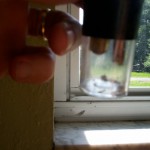 scopes can be great but they have yet to make one small enough that also has its own light source to really be effective. I have one that can fit into a 1/16 inch hole but it doesn’t help much when all I see is black.
scopes can be great but they have yet to make one small enough that also has its own light source to really be effective. I have one that can fit into a 1/16 inch hole but it doesn’t help much when all I see is black.
There are very expensive tools such as thermal imaging, listening devices, X-ray equipment and even dogs that can greatly enhance the inspection non invasively but these are out of reach for most and consumers are unwilling for the most part to pay higher prices to justify the expense.
Nothing however beats field experience regardless of the tools because without it you wouldn’t be able to know just ‘where’ to direct your efforts.
Inspections can and do involve probing and sometimes since the wood is damaged badly already or with the homeowners permission it is acceptable to ‘dig in.’ But to damage otherwise sound trim boards and cause unsightly difficult to fix and permanent marks is uncalled for.




